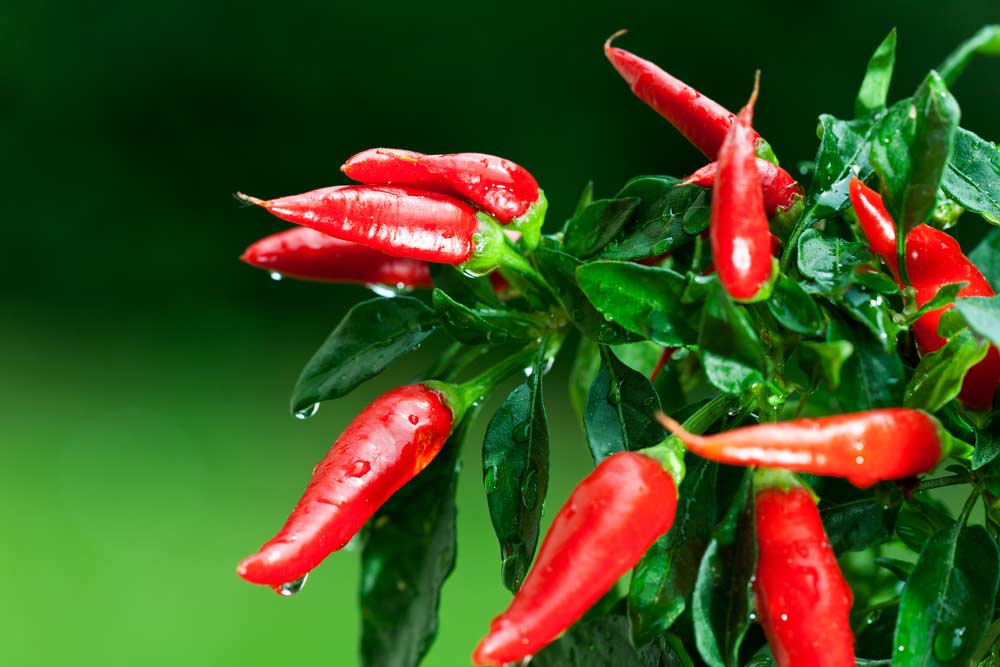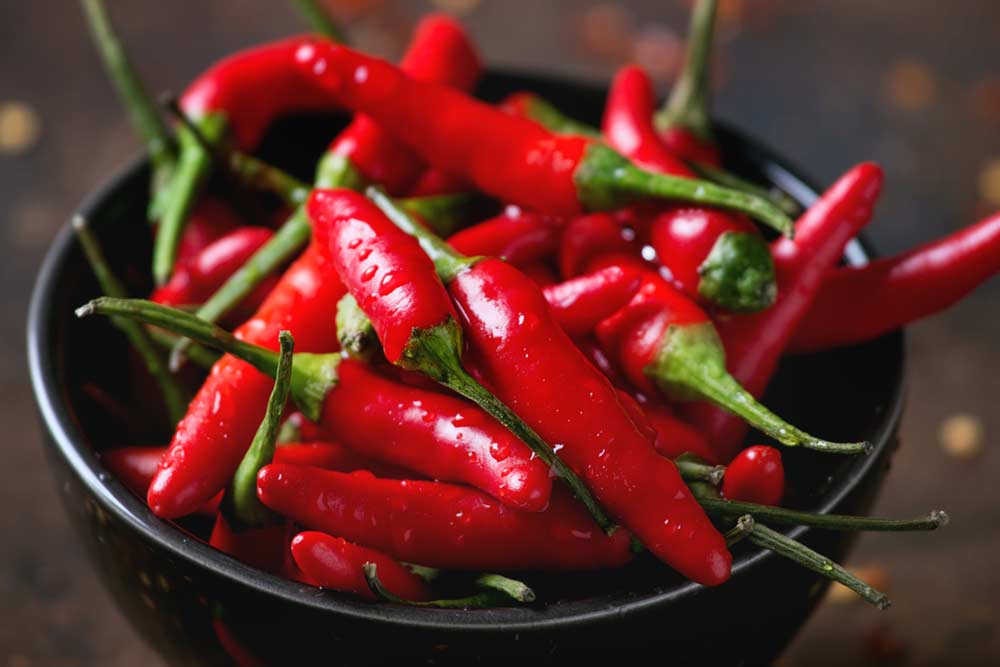Pepper does not serve only to ward off evil eye and fat eye, right? Having a little peppercorn at home can be your chance to enjoy more tasty dishes with the level of burning that you like best.
In other words: bye, bye, ready-made supermarket sauce!
But to have this little wonder of nature at home, you will first need to learn how to plant pepper the right way.
And that's exactly what we're going to talk about in today's post, come with us?
Characteristics and types of pepper

Anyone who likes pepper, must have heard of the different levels of burning that exist between species.
It is essential to know this when choosing which pepper to plant.
In general, all peppers belong to the family Solanaceae, more specifically of group of Capsicum.
Peppers are native to warm climate regions, most of which originate in South and Central America.
The first record of pepper consumption in history dates back more than 9,000 years BC, in the region of Tehuacán, Mexico.
In Brazil, however, it was the Indians who started planting and consuming peppers, collaborating with the expansion of this culture to the rest of the world soon after the arrival of the Portuguese.
And would you know what are the most popular peppers around here? Then take note of the list below and see which one can be grown there in your home.
Goat Pepper: Also known as sweet pepper, this pepper is typical of the states of Goiás, Bahia, Tocantis and Minas Gerais.
The goat pepper has a round shape and can be found green, when it is still immature, or already in yellow and red colors, indicating its maturity.
With a medium degree of burning, the goat pepper is a great accompaniment to pork meat and a beautiful feijoada.
Pepper pout: The beak pepper, as its name suggests, is round and has the shape of a beak on the end.
Perfect for those who appreciate the smell and flavor of the pepper, but cannot tolerate the sting and the spiciness of a traditional pepper. This is because, the beak pepper is not burnt, on the contrary, it has a light and even slightly sweet flavor.
Therefore, it is widely used to decorate dishes, complement salads and even for sweet preparations, such as syrups and jellies.
Chilli pepper: In contrast to beak pepper, chili peppers have an intermediate to high burning sensation.
With an elongated shape and a red color and a bright peel, the chilli pepper gives an intense flavor to dishes based on red meat. In Bahia, chili peppers are an indispensable ingredient in typical preparations such as vatapá and caruru.
Chilli pepper is also perfect for making sauces and preserves.
Pepper girl finger: The girl finger pepper is very popular in Brazil, especially in the form of sauces. With a shape that really resembles a finger, the girl's finger pepper has medium stinging and is great when combined with fatty dishes.
To leave it with a softer degree of burning, just remove the seeds.
Cumari pepper: Small, but dangerous! Cumari pepper is on the list of one of the most spicy, with a high level of burning.
Widely used in preserves, cumari pepper enhances the flavor of simple everyday dishes, such as rice and beans.
Black pepper: Black pepper is one of the most consumed in the world. Usually found in the dehydrated or powdered version, this pepper has the shape of a small grain.
With a degree of blazing between mild and medium, black pepper can be used to season everything from meats to everyday beans.
Cayenne pepper: Cayenne pepper, usually found in powder form, has a medium sting and goes very well in oriental dishes, such as Thai and Indian dishes.
Jalapeno pepper: With the popularization of Mexican cuisine in Brazil, jalapeño pepper also came.
A fundamental ingredient in preparations such as chilli, tacos and burritos, jalapeño pepper does not disappoint anyone who appreciates a stronger degree of burning. This notable little, green color, looking like a pepper, goes well with seafood-based preparations.
Pink pepper: Pink pepper is another good option for those who appreciate the aroma and flavor of peppers, but want something milder in relation to burning.
The pink pepper has a slight spiciness, despite its strong aroma. An interesting curiosity about pink pepper is that it is not actually a pepper, but the fruit of a tree known as aroeira.
Murupi Pepper: Of the Brazilian peppers, Murupi is the most ardent. Typical of the Amazon region, this pepper has a slightly greenish color.
In northern Brazil, Murupi is widely used in the preparation of fish-based dishes.
Carolina Reaper: the hottest pepper in the world
Pepper lovers must have heard of the Carolina Reaper. No, she is not a Hollywood actress, nor any celebrity.
Carolina Reaper is nothing more, nothing less, than the hottest pepper in the world!
According to Scoville, a scale created to measure the degree of hotness of the peppers, Carolina Reaper reached levels of spicy between 1,800,000 to 3,000,000. In other words, about 400 times more hot than jalapeño.
Just for the sake of comparison, the hot chilli pepper has 50,000 sting, while the girl's finger reaches levels between 5,000 and 15,000.
Carolina Reaper did not come into the world to play, no! In 2013, an American man came to have stroke-like symptoms after consuming a small portion of the pepper.
So, would you face a Carolina Reaper?
Health benefits of pepper
But peppers do not live just by burning. Did you know that they are also beneficial for human health?
Most pepper species are rich in vitamin C, as well as helping to control the blood glycemic index, that is, very suitable for diabetics.
Pepper is also a stimulant of the circulatory system. Another interesting characteristic of pepper is that it can be used in weight loss diets, since, as it is a thermogenic food, it helps in the acceleration of metabolism and in the consequent weight loss.
How to plant pepper

Ideal soil
Peppers should be planted in soil with a good percentage of organic matter. The recommendation is to mix 70% common soil to 30% organic compost, such as earthworm humus, for example.
The soil must also be well drained, since the pepper does not grow in very wet and soggy soils.
Your pepper can be planted in pots, planters or directly in the soil, if you have a garden or vegetable garden at home.
For planting, have seeds of the chosen species in hand or, if you prefer, buy the seedling already taken and just transfer it to the final location.
If you choose seeds, just remember not to cover them too much with soil. When in doubt, take a sieve and lightly sprinkle the soil over it. In each dimple, place three seeds.
Water the seeds every day with the help of a spray or sprinkler, but don't over water.
When they start to sprout, it is already possible to place them in the sun. After reaching about ten to fifteen centimeters, perform the transplant to the final location.
Light and temperature
To grow beautiful and happy, the pepper plant needs sun and warmth. This means that you must leave the pot or plant in a location that receives at least six hours of direct sunlight.
Temperature is also important. Peppers develop best under temperatures above 20º.
In fact, prefer to plant between August and December, a period when temperatures start to rise and seeds are more likely to germinate.
Watering
Watering is one of the most important things when growing pepper at home.
If you water too much, the pepper plant will rot and die, but if you stop watering, it will dry. So, if your pepperoni dried up, it may have been due to lack of water and I don’t look fat, okay?
When in doubt, the tip is to touch the earth with your fingertips. If you leave with a dirty finger, a sign that the soil is still damp and does not need more water, but if you notice the crumbling soil and no sign of it on your fingers, you can water it.
Fertilizing
To make the pepper plant stronger, healthier and happier, fertilize it every two months or so.
Prefer organic fertilizers, since you will consume the fruits. You can use earthworm humus or even make your own compost at home using a home compost.
Along with fertilization, also take the opportunity to check on the health of your pepper plant. If you notice yellow, dry leaves, cut them off. Fungi and aphids can be common as well, so always check for pests in the pepper plant.
Time to harvest
When you notice the presence of the first flowers, take a pair of scissors and cut them. That's right, cut the first flowers of the pepper plant so that it grows more strongly, so in the next flowering it will present you with bigger and better quality peppers.
In some species, it is already possible to harvest the first peppers 60 days after transplanting the seedling.
To harvest, prefer the less hot moments of the day, such as early morning and late afternoon.
Always use pruning shears to harvest and do not damage the branches of the plant.
Be careful when handling peppers. Some of them, due to the high degree of burning, can cause itching and even skin burns. The tip is always to wear gloves.
Ready to start growing pepper at home? So get to work!



